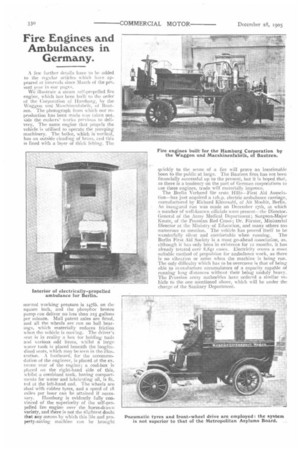Fire Engines and Ambulances in Germany.
Page 14

If you've noticed an error in this article please click here to report it so we can fix it.
A few further details have to be added to the regular articles which have appeared at intervals since March of the present year in our
We illustrate a steam self-propelled fire engine, Nvhich has been built to the order of the Corporation of Hamburg, by the Waggon nod Maschinentabrik, of Bautzen. The photograph from which our reproduction has been rondo was taken outside the makers works previous to delivery. The same engine that propels the vehicle is utilised to operate the pumping machinery. The boiler, which is vertical, has an outside deeding of brass, and this is lined with a layer of thick felting. The normal working pressure is 1471b. on die square inch, and the phosphor bronze pump can deliver no less than 225 gallons per minute. Mail patent axles are fitted, and all the wheels are run on ball bearings, which materially reduces friction when the vehicle is moving. The driver's scat is in reality a box tor holding tools and various odd items, whilst a large water tank is placed beneath the longitudinal seats, which may he seen in the illus_ tration. A footboard, for the accommodation of the engineer, is placed at the ex_ treme rear of the engine; a coal-box is placed on the right-hand side of this, whilst a combined tank, having compartments for water and lubricating oil, is fit_ red at the left-hand end. The wheels are shod with rubber tyres, and a speed of 18 miles per hour can be attained if neces
sary. Itainburg is evidently fully convinced of the superiority of the self-propelled fire engine over the horse-drawn variety, and there is not the slightest doubt that any means by which this life and property-saving machine can be brought
quickly to the scene of a fire will prove an inestimable boon to the public at large. The Bautzen firm has not been financially successful up to the present, but it is hoped that, as there is a tendency on the part of German corporations to use these engines, trade will materially improve.
The Berlin Verband far erste Hilfe—First Aid Association—has just acquired a 12h.p. electric ambulance carriage, manufactured by Richard klevesahl, of Alt Moabit, An inaugural run was made on December 171h, at which a number of well-known officials were present—the DirectorGeneral of the Army Medical Department; Surgeon-Major Knute, of the Prussian Red Cross; Dr. Fiirster, Ministerial Director at the Ministry of Education, and many others too numerous to mention. The vehicle has proved itself to be wonderfully silent and comfortable when running. The Berlin First Aid Society is a most go-ahead association, as, although it has only been in existence for 12 months, it has already treated over 8,842 cases. Electricity seems a mast suitable method of propulsion for ambulance work, as there is no vibration or noise when the machine is being run. The only difficulty which has to be overcome is that of being able to manufacture accumulators of a capacity capable of running long distances without their being unduly heavy. The Prussian army authorities have ordered a similar vehicle to the one mentioned above, which will be under the charge of the Sanitary Department.
















